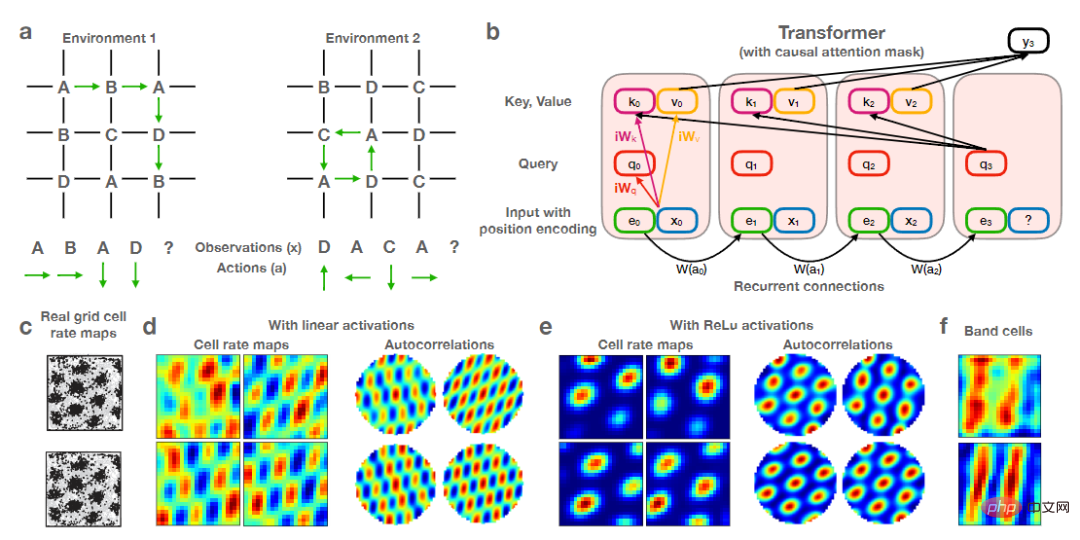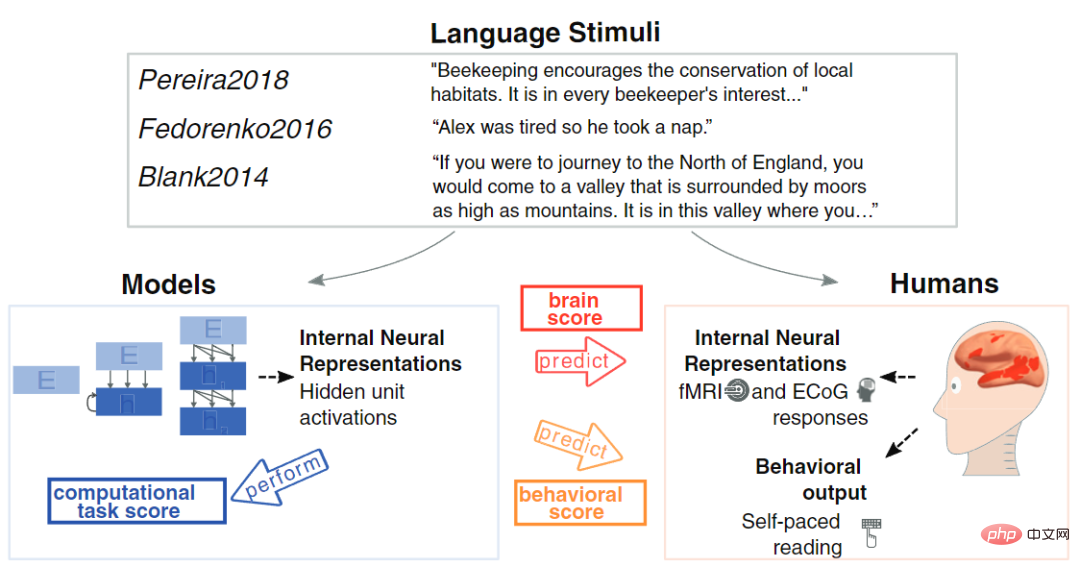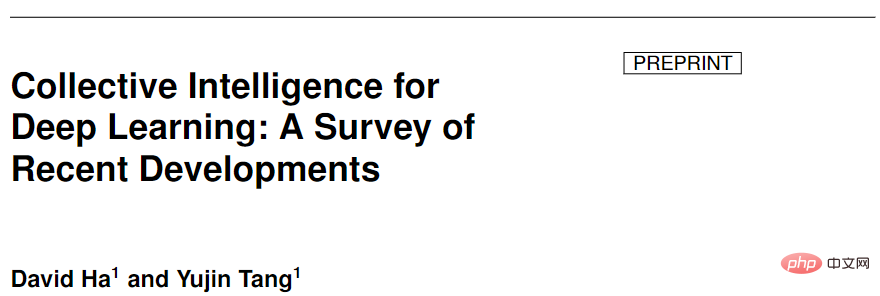 Technology peripherals
Technology peripherals
 AI
AI
 There is also a Transformer in the brain! The same mechanism as the 'hippocampus'
There is also a Transformer in the brain! The same mechanism as the 'hippocampus'
There is also a Transformer in the brain! The same mechanism as the 'hippocampus'
I can't create it, I don't understand —— Feiman
## If wanting to create artificial intelligence, we must first understand the human brain cause How intelligent.
With the birth of neural networks and their subsequent brilliant development, researchers have been looking for biological explanations and biological progress for neural networks. It is also inspiring AI researchers to develop new models.

But researchers in the field of artificial intelligence actually have a more ambitious pursuit: Use AI models to help understand the brain .
Recent research has found that although the most popular Transformer model was developed without any assistance from biological knowledge , but its structure is very similar to the hippocampal structure of the human brain.
 ##Paper link: https://arxiv.org/pdf/2112.04035.pdf
##Paper link: https://arxiv.org/pdf/2112.04035.pdf
After the researchers equipped the Transformer with recursive position encoding, they found that the model could accurately replicate the spatial representation
of the hippocampal formation.However, the author also said that he is not surprised by this result, because Transformer is closely related to the current hippocampal model
in neuroscience, the most obvious one isPlace cells(place cells) and Grid cells(grid cells). Moreover, it was found through experiments that the Transformer model has a huge performance improvement compared to the model provided by the neuroscience version.
This work combines artificial neural networks with computational brain networks to provide new understanding of the interaction between the hippocampus and cerebral cortex, And hints at how cortical areas perform a wider range of complex tasks beyond current neuroscientific models, such as language understanding.
Transformer simulates the hippocampus? It is still difficult for humans to understand their own brains. For example, studying how the brain organizes and accesses spatial information to solve "where we are, what's around the corner, and how to get there" is still a daunting task. challenges.
The entire process may involve calling entire memory networks and stored spatial data from tens of billions of neurons, each connected to thousands of other neurons.
While neuroscientists have identified several key elements, such as grid cells, neurons that map location, how to go deeper remains unknown: researchers cannot move Divide and study slices of human gray matter to see how location-based memories of images, sounds and smells flow and connect to each other.
Artificial intelligence models provide another way to understand the human brain. Over the years, neuroscientists have used various types of neural networks to simulate the firing of neurons in the brain.
Recent research shows that the hippocampus (a brain structure crucial for memory) is basically similar to the Transformer model.
The researchers used the new model to track spatial information in a way that is similar to the inner workings of the brain, and achieved some remarkable results.
James Whittington, a cognitive neuroscientist from the University of Oxford and Stanford University, said that when we know that these brain models are equivalent to Transformer, it means The new model will perform better and be easier to train.
As seen in the work of Whittington and others, Transformer can greatly improve the ability of neural network models to imitate the various calculations performed by grid cells and other parts of the brain.
Whittington says such models could advance our understanding of how artificial neural networks work and, more likely, how computations are performed in the brain.
David Ha, a computer scientist at Google Brain who is mainly engaged in Transformer model research, said that we are not trying to recreate a new brain, but can we create a mechanism to do what the brain can do? thing?
Transformer was first proposed five years ago as a new model for artificial intelligence to process natural language. It was also the secret weapon of "star models" such as BERT and GPT-3. . These models can generate convincing song lyrics, compose Shakespearean sonnets, or do some human customer service work.
The core mechanism of Transformer is self-attention, in which each input (such as a word, a pixel, a number in a sequence) is always connected to all other inputs, and other Common neural networks simply connect inputs to certain inputs.
Although Transformer was designed specifically for natural language tasks, subsequent research has also proven that Transformer also performs well in other tasks, such as classifying images, and now The brain is modeled.
In 2020, a team led by Sepp Hochreiter, a computer scientist at Johann Kepler University in Linz, Austria (the first author of the LSTM paper), used a Transformer to repurpose a powerful, long-term The existing memory retrieval model Hopfield network.
These networks, first proposed 40 years ago by Princeton physicist John Hopfield, follow a general rule: Neurons that are active at the same time establish strong connections with each other.
Hochreiter and his collaborators noted that researchers are always looking for better models of memory retrieval, and they saw how a new class of Hopfield networks retrieves memories and how Transformers perform attention. connection between forces.
These new Hopfield networks, developed by Hopfield and Dmitry Krotov of the MIT-IBM Watson Artificial Intelligence Laboratory, feature more efficient connections than standard Hopfield networks , more memories can be stored and retrieved.

Paper link: https://papers.nips.cc/paper/2016/hash/eaae339c4d89fc102edd9dbdb6a28915-Abstract.html
Hochreiter’s team upgraded these networks by adding a rule similar to the attention mechanism in Transformer.
In 2022, this new paper further adjusted Hochreiter's method and modified the Transformer so that it no longer treats memory as a linear sequence, but like a string in a sentence words, encoding them as coordinates in a high-dimensional space.
The researchers say this "twist" further improves the model's performance on neuroscience tasks. The experimental results also showed that the model is mathematically equivalent to the model of grid cell firing patterns that neuroscientists see in fMRI scans.
Grid cells have this exciting, beautiful, regular structure with striking patterns, says Caswell Barry, a neuroscientist at University College London. Too likely to appear randomly.
This new work shows how exactly the Transformer replicates those patterns observed in the hippocampus.

They also realized that the Transformer model can figure out where it is based on its previous state and how it moved, and in a key way way into the traditional grid cell model.
Other recent work also suggests that Transformers can advance our understanding of other brain functions.
Last year, computational neuroscientist Martin Schrimpf of MIT analyzed 43 different neural network models to understand their effects on human neural activity measurements reported by fMRI and electrocorticography. How predictable are the results.

He found that Transformer is currently the leading and most advanced neural network and can predict almost all changes found in imaging.
David Ha and Yujin Tang, also a computer scientist, recently designed a model that can deliberately input large amounts of data to the Transformer in a random and disorderly manner, simulating how the human body transmits data to the brain. Transmitting sensory observations. It turns out that Transformer can successfully process disordered information flows just like our brains.

##Paper link: https://arxiv.org/abs/2111.14377
Yujin Tang said that neural networks are hardwired and can only receive specific inputs. But in real life, data sets often change rapidly, and most AIs don’t have any way to adjust. In the future we would like to try an architecture that can adapt quickly.
The above is the detailed content of There is also a Transformer in the brain! The same mechanism as the 'hippocampus'. For more information, please follow other related articles on the PHP Chinese website!

Hot AI Tools

Undresser.AI Undress
AI-powered app for creating realistic nude photos

AI Clothes Remover
Online AI tool for removing clothes from photos.

Undress AI Tool
Undress images for free

Clothoff.io
AI clothes remover

AI Hentai Generator
Generate AI Hentai for free.

Hot Article

Hot Tools

Notepad++7.3.1
Easy-to-use and free code editor

SublimeText3 Chinese version
Chinese version, very easy to use

Zend Studio 13.0.1
Powerful PHP integrated development environment

Dreamweaver CS6
Visual web development tools

SublimeText3 Mac version
God-level code editing software (SublimeText3)

Hot Topics
 1378
1378
 52
52
 The world's most powerful open source MoE model is here, with Chinese capabilities comparable to GPT-4, and the price is only nearly one percent of GPT-4-Turbo
May 07, 2024 pm 04:13 PM
The world's most powerful open source MoE model is here, with Chinese capabilities comparable to GPT-4, and the price is only nearly one percent of GPT-4-Turbo
May 07, 2024 pm 04:13 PM
Imagine an artificial intelligence model that not only has the ability to surpass traditional computing, but also achieves more efficient performance at a lower cost. This is not science fiction, DeepSeek-V2[1], the world’s most powerful open source MoE model is here. DeepSeek-V2 is a powerful mixture of experts (MoE) language model with the characteristics of economical training and efficient inference. It consists of 236B parameters, 21B of which are used to activate each marker. Compared with DeepSeek67B, DeepSeek-V2 has stronger performance, while saving 42.5% of training costs, reducing KV cache by 93.3%, and increasing the maximum generation throughput to 5.76 times. DeepSeek is a company exploring general artificial intelligence
 AI subverts mathematical research! Fields Medal winner and Chinese-American mathematician led 11 top-ranked papers | Liked by Terence Tao
Apr 09, 2024 am 11:52 AM
AI subverts mathematical research! Fields Medal winner and Chinese-American mathematician led 11 top-ranked papers | Liked by Terence Tao
Apr 09, 2024 am 11:52 AM
AI is indeed changing mathematics. Recently, Tao Zhexuan, who has been paying close attention to this issue, forwarded the latest issue of "Bulletin of the American Mathematical Society" (Bulletin of the American Mathematical Society). Focusing on the topic "Will machines change mathematics?", many mathematicians expressed their opinions. The whole process was full of sparks, hardcore and exciting. The author has a strong lineup, including Fields Medal winner Akshay Venkatesh, Chinese mathematician Zheng Lejun, NYU computer scientist Ernest Davis and many other well-known scholars in the industry. The world of AI has changed dramatically. You know, many of these articles were submitted a year ago.
 Google is ecstatic: JAX performance surpasses Pytorch and TensorFlow! It may become the fastest choice for GPU inference training
Apr 01, 2024 pm 07:46 PM
Google is ecstatic: JAX performance surpasses Pytorch and TensorFlow! It may become the fastest choice for GPU inference training
Apr 01, 2024 pm 07:46 PM
The performance of JAX, promoted by Google, has surpassed that of Pytorch and TensorFlow in recent benchmark tests, ranking first in 7 indicators. And the test was not done on the TPU with the best JAX performance. Although among developers, Pytorch is still more popular than Tensorflow. But in the future, perhaps more large models will be trained and run based on the JAX platform. Models Recently, the Keras team benchmarked three backends (TensorFlow, JAX, PyTorch) with the native PyTorch implementation and Keras2 with TensorFlow. First, they select a set of mainstream
 KAN, which replaces MLP, has been extended to convolution by open source projects
Jun 01, 2024 pm 10:03 PM
KAN, which replaces MLP, has been extended to convolution by open source projects
Jun 01, 2024 pm 10:03 PM
Earlier this month, researchers from MIT and other institutions proposed a very promising alternative to MLP - KAN. KAN outperforms MLP in terms of accuracy and interpretability. And it can outperform MLP running with a larger number of parameters with a very small number of parameters. For example, the authors stated that they used KAN to reproduce DeepMind's results with a smaller network and a higher degree of automation. Specifically, DeepMind's MLP has about 300,000 parameters, while KAN only has about 200 parameters. KAN has a strong mathematical foundation like MLP. MLP is based on the universal approximation theorem, while KAN is based on the Kolmogorov-Arnold representation theorem. As shown in the figure below, KAN has
 Hello, electric Atlas! Boston Dynamics robot comes back to life, 180-degree weird moves scare Musk
Apr 18, 2024 pm 07:58 PM
Hello, electric Atlas! Boston Dynamics robot comes back to life, 180-degree weird moves scare Musk
Apr 18, 2024 pm 07:58 PM
Boston Dynamics Atlas officially enters the era of electric robots! Yesterday, the hydraulic Atlas just "tearfully" withdrew from the stage of history. Today, Boston Dynamics announced that the electric Atlas is on the job. It seems that in the field of commercial humanoid robots, Boston Dynamics is determined to compete with Tesla. After the new video was released, it had already been viewed by more than one million people in just ten hours. The old people leave and new roles appear. This is a historical necessity. There is no doubt that this year is the explosive year of humanoid robots. Netizens commented: The advancement of robots has made this year's opening ceremony look like a human, and the degree of freedom is far greater than that of humans. But is this really not a horror movie? At the beginning of the video, Atlas is lying calmly on the ground, seemingly on his back. What follows is jaw-dropping
 Time Series Forecasting NLP Large Model New Work: Automatically Generate Implicit Prompts for Time Series Forecasting
Mar 18, 2024 am 09:20 AM
Time Series Forecasting NLP Large Model New Work: Automatically Generate Implicit Prompts for Time Series Forecasting
Mar 18, 2024 am 09:20 AM
Today I would like to share a recent research work from the University of Connecticut that proposes a method to align time series data with large natural language processing (NLP) models on the latent space to improve the performance of time series forecasting. The key to this method is to use latent spatial hints (prompts) to enhance the accuracy of time series predictions. Paper title: S2IP-LLM: SemanticSpaceInformedPromptLearningwithLLMforTimeSeriesForecasting Download address: https://arxiv.org/pdf/2403.05798v1.pdf 1. Large problem background model
 FisheyeDetNet: the first target detection algorithm based on fisheye camera
Apr 26, 2024 am 11:37 AM
FisheyeDetNet: the first target detection algorithm based on fisheye camera
Apr 26, 2024 am 11:37 AM
Target detection is a relatively mature problem in autonomous driving systems, among which pedestrian detection is one of the earliest algorithms to be deployed. Very comprehensive research has been carried out in most papers. However, distance perception using fisheye cameras for surround view is relatively less studied. Due to large radial distortion, standard bounding box representation is difficult to implement in fisheye cameras. To alleviate the above description, we explore extended bounding box, ellipse, and general polygon designs into polar/angular representations and define an instance segmentation mIOU metric to analyze these representations. The proposed model fisheyeDetNet with polygonal shape outperforms other models and simultaneously achieves 49.5% mAP on the Valeo fisheye camera dataset for autonomous driving
 Tesla robots work in factories, Musk: The degree of freedom of hands will reach 22 this year!
May 06, 2024 pm 04:13 PM
Tesla robots work in factories, Musk: The degree of freedom of hands will reach 22 this year!
May 06, 2024 pm 04:13 PM
The latest video of Tesla's robot Optimus is released, and it can already work in the factory. At normal speed, it sorts batteries (Tesla's 4680 batteries) like this: The official also released what it looks like at 20x speed - on a small "workstation", picking and picking and picking: This time it is released One of the highlights of the video is that Optimus completes this work in the factory, completely autonomously, without human intervention throughout the process. And from the perspective of Optimus, it can also pick up and place the crooked battery, focusing on automatic error correction: Regarding Optimus's hand, NVIDIA scientist Jim Fan gave a high evaluation: Optimus's hand is the world's five-fingered robot. One of the most dexterous. Its hands are not only tactile



